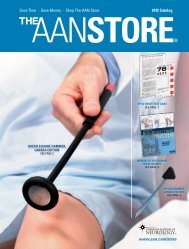Practice parameter: Evaluating a first nonfebrile seizure in children
Practice parameter: Evaluating a first nonfebrile seizure in children
Practice parameter: Evaluating a first nonfebrile seizure in children
You also want an ePaper? Increase the reach of your titles
YUMPU automatically turns print PDFs into web optimized ePapers that Google loves.
ness between <strong>seizure</strong>s. 5 Children with significant<br />
head trauma immediately preced<strong>in</strong>g the <strong>seizure</strong> or<br />
those with previously diagnosed CNS <strong>in</strong>fection or<br />
tumor or other known acute precipitat<strong>in</strong>g causes are<br />
excluded. We excluded neonatal <strong>seizure</strong>s (�28 days),<br />
<strong>first</strong> <strong>seizure</strong>s last<strong>in</strong>g 30 m<strong>in</strong>utes or more (status epilepticus),<br />
and febrile <strong>seizure</strong>s, because these disorders<br />
are diagnostically and therapeutically different.<br />
The American Academy of Pediatrics has recently<br />
published recommendations for evaluation of <strong>children</strong><br />
with a <strong>first</strong> simple febrile <strong>seizure</strong>. 6<br />
Description of process. An <strong>in</strong>itial MEDLINE literature<br />
search was performed for relevant articles<br />
published from 1980 to August 1996, us<strong>in</strong>g the follow<strong>in</strong>g<br />
key words: epilepsy, <strong>seizure</strong>s, convulsions,<br />
magnetic resonance imag<strong>in</strong>g, computed tomography,<br />
electroencephalography, blood chemical analysis,<br />
neurological exam<strong>in</strong>ation, and diagnostic errors.<br />
Standard search procedures were used, and subhead<strong>in</strong>gs<br />
were applied as appropriate. In addition,<br />
the database provided by Current Contents was<br />
searched for the most recent 6-month period. These<br />
searches produced 279 titles of journal articles <strong>in</strong><br />
English, and 79 <strong>in</strong> non-English languages. An updated<br />
MEDLINE search was performed <strong>in</strong> June 1997<br />
and aga<strong>in</strong> <strong>in</strong> November 1998.<br />
Titles and abstracts were reviewed for content regard<strong>in</strong>g<br />
<strong>first</strong> <strong>nonfebrile</strong> <strong>seizure</strong>s <strong>in</strong> <strong>children</strong> and<br />
adults. Articles from the searches were identified for<br />
review and additional articles from the references <strong>in</strong><br />
these primary articles were <strong>in</strong>cluded. Articles were<br />
excluded if they conta<strong>in</strong>ed only data on adults with<br />
established epilepsy, but references were reviewed<br />
perta<strong>in</strong><strong>in</strong>g to adults with <strong>first</strong> <strong>seizure</strong>s only, to both<br />
<strong>children</strong> and adults with <strong>first</strong> <strong>seizure</strong>s, and to <strong>children</strong><br />
with both new and established <strong>seizure</strong>s. Two of<br />
the articles published <strong>in</strong> non-English languages met<br />
our criteria and were <strong>in</strong>cluded. Of the articles reviewed<br />
from searches, bibliographies, and committee<br />
member suggestions, 66 met the above criteria and<br />
were <strong>in</strong>cluded as references. The age ranges <strong>in</strong>cluded<br />
<strong>in</strong> the studies were variable, and most pediatric<br />
studies <strong>in</strong>cluded up to age 16 to 19 years. In most<br />
reports, results were not broken down accord<strong>in</strong>g to<br />
subsets of age groups.<br />
A new three-tiered scheme of classification of evidence<br />
was developed specifically to be used for evaluation<br />
of diagnostic studies (Appendix 1). This<br />
classification scheme was approved by the QSS of<br />
the AAN and differs from one that has been used for<br />
the assessment of treatment efficacy studies, which<br />
largely perta<strong>in</strong>s to randomized trials.<br />
Each of the selected articles was reviewed, abstracted,<br />
and classified by at least two reviewers.<br />
Abstracted data <strong>in</strong>cluded patient numbers, ages and<br />
gender, tim<strong>in</strong>g of subject selection (prospective, retrospective,<br />
or referral), case-f<strong>in</strong>d<strong>in</strong>g methods, exclusion<br />
criteria, <strong>seizure</strong> characteristics, neurologic<br />
abnormalities prior to or after the <strong>seizure</strong>, evalua-<br />
tions and results, and recommendations of the authors.<br />
Methods of data analysis were also noted.<br />
Goals of immediate evaluation. After stabilization<br />
of the child, a physician must determ<strong>in</strong>e if a<br />
<strong>seizure</strong> has occurred, and if so, if it is the child’s <strong>first</strong><br />
episode. It is critical to obta<strong>in</strong> as detailed a history<br />
as possible at the time of presentation. The determ<strong>in</strong>ation<br />
that a <strong>seizure</strong> has occurred is typically based<br />
on a detailed history provided by a reliable observer<br />
(Appendix 2). A careful history and neurologic exam<strong>in</strong>ation<br />
may allow a diagnosis without need for further<br />
evaluation. Children can present with <strong>seizure</strong>-like<br />
symptoms that may not <strong>in</strong> fact represent actual <strong>seizure</strong>s,<br />
but rather breath-hold<strong>in</strong>g spells, syncope,<br />
gastro–esophageal reflux, pseudo<strong>seizure</strong>s (psychogenic),<br />
and other nonepileptic events. No s<strong>in</strong>gle cl<strong>in</strong>ical<br />
symptom can reliably discrim<strong>in</strong>ate between a<br />
<strong>seizure</strong> and a nonepileptic event. 7,8 Studies have <strong>in</strong>vestigated<br />
whether serum prolact<strong>in</strong> levels 9,10 or creat<strong>in</strong>e<br />
k<strong>in</strong>ase levels 11 may help dist<strong>in</strong>guish <strong>seizure</strong>s<br />
from nonepileptic events, but neither of these tests is<br />
sufficiently reliable to use rout<strong>in</strong>ely.<br />
The next goal of assessment is to determ<strong>in</strong>e the<br />
cause of the <strong>seizure</strong>. In many <strong>children</strong>, the history<br />
and physical exam<strong>in</strong>ation alone will provide adequate<br />
<strong>in</strong>formation regard<strong>in</strong>g probable cause of the<br />
<strong>seizure</strong> 12 or the need for other tests <strong>in</strong>clud<strong>in</strong>g neuroimag<strong>in</strong>g.<br />
13 The etiology of the <strong>seizure</strong> may necessitate<br />
prompt treatment or provide important prognostic <strong>in</strong>formation.<br />
Provoked <strong>seizure</strong>s are the result of an acute<br />
condition such as hypoglycemia, toxic <strong>in</strong>gestion, <strong>in</strong>tracranial<br />
<strong>in</strong>fection, trauma, or other precipitat<strong>in</strong>g factors.<br />
Unprovoked <strong>seizure</strong>s occur <strong>in</strong> the absence of such factors;<br />
their etiology may be cryptogenic (no known<br />
cause), remote symptomatic (pre-exist<strong>in</strong>g bra<strong>in</strong> abnormality<br />
or <strong>in</strong>sult), or idiopathic (genetic).<br />
Laboratory studies. Evidence. In one Class I<br />
study of 30 <strong>children</strong> ages 0 to 18 years, and 133<br />
adults with <strong>seizure</strong>s, of whom 24 (15%) had new<br />
onset <strong>seizure</strong>s, the standard diagnostic laboratory<br />
workup, which <strong>in</strong>cluded complete blood count (CBC),<br />
serum electrolytes, blood urea nitrogen (BUN), creat<strong>in</strong><strong>in</strong>e,<br />
glucose, calcium, and magnesium, revealed<br />
one case of hyperglycemia that was unsuspected cl<strong>in</strong>ically<br />
14 (95% CI 0, 4.9%). This patient’s age was not<br />
noted, nor were those with new onset <strong>seizure</strong>s identified<br />
by age. Another prospective study of 136 new<br />
onset <strong>seizure</strong> patients found no cl<strong>in</strong>ically significant<br />
laboratory abnormalities <strong>in</strong> the 16 <strong>children</strong> <strong>in</strong> the<br />
study who were ages 12 to 19 years 15 (95% CI 0, 19%).<br />
In two Class II studies <strong>in</strong>clud<strong>in</strong>g 507 <strong>children</strong><br />
with both febrile and <strong>nonfebrile</strong> <strong>seizure</strong>s, results of<br />
laboratory studies did not contribute to diagnosis or<br />
management. 12,16 In another Class II study <strong>in</strong>clud<strong>in</strong>g<br />
65 <strong>children</strong> with new onset <strong>seizure</strong>s not accompanied<br />
by fever, one had a positive coca<strong>in</strong>e screen, and<br />
seven had electrolyte abnormalities (additional data<br />
supplied by the author of reference 17). Of these,<br />
four <strong>children</strong> were hyponatremic and three were hy-<br />
September (1 of 2) 2000 NEUROLOGY 55 617



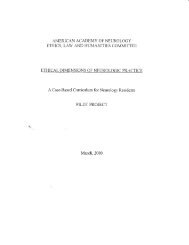

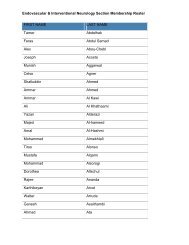
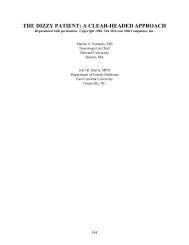

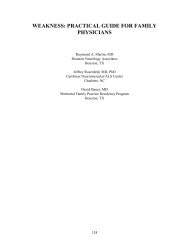
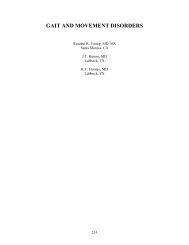
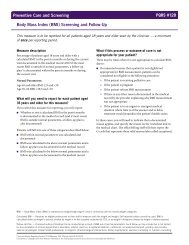
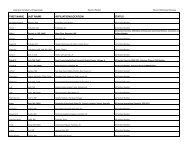
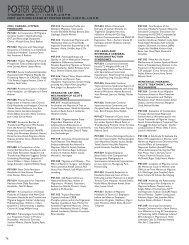
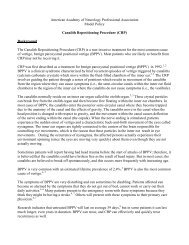
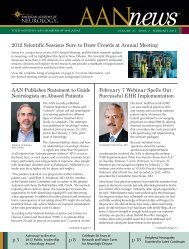
![[Click here and type date] - American Academy of Neurology](https://img.yumpu.com/8582972/1/190x245/click-here-and-type-date-american-academy-of-neurology.jpg?quality=85)
